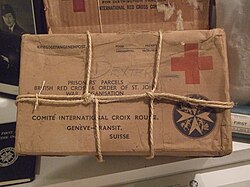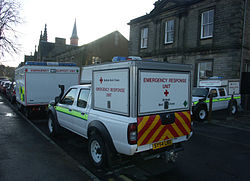British Red Cross
The British Red Cross is the United Kingdom body of the neutral humanitarian network the Red Cross. The society was formed in 1870 and is a registered charity with over 32,500 volunteers and 3500 staff.[1] The charity helps people both in the UK and overseas and are not biased towards any faith or other belief.
| British Red Cross | |
|---|---|
| Abbreviation | BRC |
| Formation | 1870 |
| Type | Charitable organisation |
| Legal status | Incorporated by Royal Charter |
| Purpose/focus | Humanitarian aid |
| Headquarters | London, EC2, United Kingdom |
| Parent organization | International Red Cross and Red Crescent Movement |
| Website | https://www.redcross.org.uk/ |
Guiding ethos
The mission of the British Red Cross is to help people across the country. The organization has seven fundamental principles (given by the International Red Cross and Red Crescent Movement) that staff and volunteers must follow:
- Humanity
- Impartiality
- Neutrality
- Independence
- Voluntary Service
- Unity
- Universality
The British Red Cross also has four local values, which guide the way they work:
- Compassionate
- Inclusive
- Dynamic
- Courageous
The British Red Cross is recognised by the UK Government as one of three Voluntary Aid Societies, the other two being St John Ambulance and St Andrew's Ambulance Association. [2] They are the sole Red Cross Society for the United Kingdom and the British Overseas Territories.
Activities
The British Red Cross operate an Emergency Response service, which act to support the governmental emergency services in times of crisis.
For example, first aid support (and distribution of first aid supplies), managing a disaster appeal scheme or providing telephone support lines after a disaster are frequent tasks of the British Red Cross. All services of the British Red Cross can be used for the emergency response service if needed. For example, ambulances belonging to the British Red Cross can be used to help the NHS in caring for the injured.
The British Red Cross will (and have done before) deal with emergencies in the UK, such as the Manchester Arena Bombing or the Grenfell Tower fire, as well as more environmental emergencies such as floods. They do not send volunteers abroad to help in emergencies as these are dealt with by the local emergency services.
First Aid Ambulance Provision
The IRC (International Red Cross movement) is the largest provide of first aid in the world and the British Red Cross frequently provide first aid at sports events, concerts and other large events.
The training done by Event First Aid Service volunteers varies, but all of them have access to advanced training, becoming part of an Ambulance Crew or even becoming a fully qualified ambulance technician. The British Red Cross do employ paramedics, but they do not train them in-house.
British Red Cross Media
A three-quarter length portrait of a Red Cross and Order of St John barge orderly, wearing sandy coloured shorts, pith helmet and white shirt. He stands side on and holds a wooden barge pole in his right hand. He appears to be standing on the deck of a boat, with the River Tigris and buildings on the riverbank visible behind him, 1919.
A first aid treatment unit (FATU) Ford Transit, that was used by the Event First Aid Team in England.
British Red Cross Renault Master emergency ambulance, used by the Ambulance Support team
Fleet Support vehicle - Land Rover Discovery, that is used by the BRC Fleet Support Team, supporting BRC ambulances
British Red Cross ESU and ERU in Inverness
British Red Cross Ambulance - Land Rover Defender. This was used at an event called Armed Forces Day.
References
- ↑ "Introducing the British Red Cross" (PDF).[dead link]
- ↑ "Royal Charter of the British Red Cross. Article 3" (PDF). 13 February 2019. Archived from the original on 1 February 2009. Retrieved 13 February 2019.
{{cite web}}: CS1 maint: bot: original URL status unknown (link)








